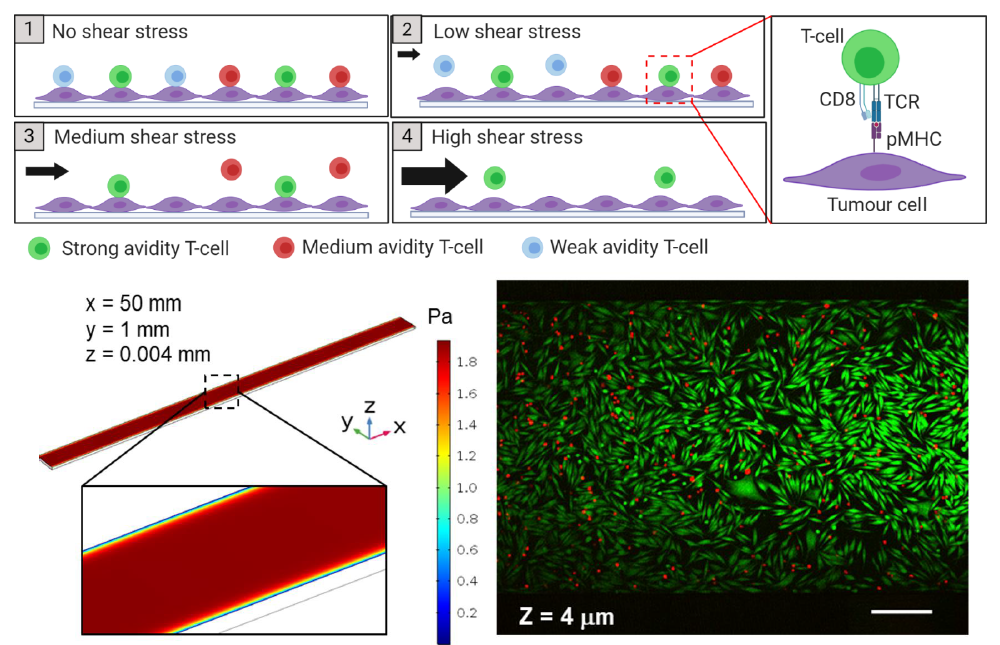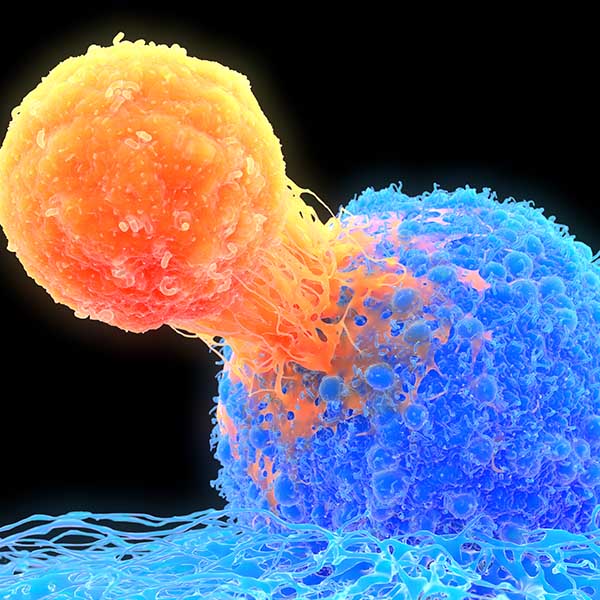A microfluidic device designed to accelerate the development of T-cell immunotherapies for cancer.
Proposed use
Immunotherapy is an approach to treat diseases including cancer, using body’s natural immune defenses. A type of immunotherapy is adoptive cell therapy, where immune cells in the body are isolated and modified to enhance their ability to kill cancer cells. These cells are then re-introduced into patients.
A form of adoptive cell therapy is T-cell immunotherapy. To develop a new T-cell therapy is a lengthy and costly process, due to the slow process of identifying and isolating effective T-cell types from trillions of available clonotypes. Selection of T-cell types with optimal T-cell receptors (TCR) is crucial for the success of T-cell therapies. This is because the binding strength between immune proteins and the TCRs determines whether an immune response against cancer cells will be triggered or not.
Problem addressed
Current methods of TCR identification include an artificial FACs-based cell-free tetramer method that studies how well TCRs bind to cancer antigens. However, this technique is time-consuming and has difficulty in identifying optimal TCRs for personalised cancer treatment.
The proposed technology is a microfluidic lab-on-a-chip device that provides a method for accurate selection of optimal TCR candidates for cancer immunotherapies. This will accelerate the adoptive cell therapy drug discovery pipeline, eliminating the drug candidates destined to fail in clinical trials. Identifying which T-cell candidates are most likely to fail or succeed in clinical trials earlier on will save drug companies significant costs. In addition, this invention allows to create personalised T-cell therapies without immune rejection concerns.
Technology overview
In this cell-based technology, both patient tumour cells and their T-cells are seeded onto the same device. The device probes thousands-millions different T-cell to tumour cell interactions at once to identify and collect the T cells with the best avidity. T-cells with high physiological binding strengths (avidity) to tumour cells typically generate a better anti-tumour response.
The device is capable of probing up to 10,000 interactions in 30 minutes and could help assess many co-stimulatory and co-inhibitory signals involved in the activation of T-cells, in addition to functional analyses such as the ability of T-cells to bind and destroy tumour cells.
While probing the interactions, the device also sorts and collects the highly potent T-cells from the mixed population of T-cells. The device has shown up to 100% purity of optimal T-cells in the samples collected.

The technology works by seeding antigen-presenting cells in the microfluidic device and flowing over T-cells with specific TCRs to bind these antigen-presenting cells. Then, a defined, uniform shear stress is applied through the device to eliminate unbound or weakly bound T-cells and to know the baseline avidity of T-cells. Increasing shear stress is then applied across the device to detach T-cells with increasing avidity. With each increasing level of avidity, cells are collected in the device to select optimal T-cells for the patient.
The device is carefully designed with optimised geometries and aspect ratios including side channels to shuttle non-uniform shear cells into a waste outlet. In addition, the device has a Poly-L-lysine surface coating to allow antigen-presenting cells to form strongly adherent and confluent cell monolayers that T-cells can bind before shear stress application. The shear stress applied through the device is carefully considered as well. Too high of a shear stress can detach or kill T-cells, while too low shear stress cannot allow discrimination of optimal cells.
Benefits
- Selects promising T cell candidates by cellular avidity in under one hour
- Selects for activated T cells by comprehensive markers of T cell activation including immunological synapse formation
- Capable of interrogating 10,000 interacting T cell target cell binding partners simultaneously
- Easily scalable
- Viable T cells are easily recovered for downstream analyses
- Potential to identify potent TCR T cell candidates preclinically based on avidity to increase chances of success in clinical trials
- Ability to assess T cell interactions to healthy or low expressing target cells to examine on target/off tumour effects
- Compatible with supplemental assays of T cell activation and function on chip
Intellectual property information
PCT/GB2022/051399 – Method for sorting cells based on avidity interactions


